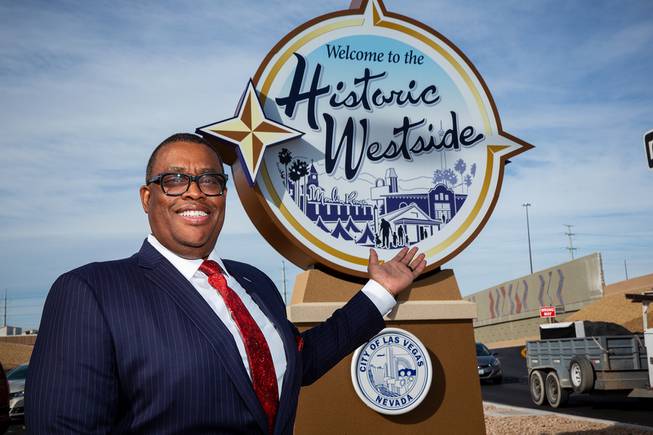Sign Project Highlights Fellowship of Historic Westside in Las Vegas
Sign Project Highlights Fellowship of Historic Westside in Las Vegas
February 1, 2021
By Ray Brewer | Las Vegas Sun
Las Vegas City Councilman Cedric Crear was getting gas at the station on Martin Luther King Boulevard and Bonanza Road last week when a somewhat familiar face pulled up.
Crear couldn’t recall his name, even seeing the man’s Las Vegas Convention Center work shirt, and quickly tried to recall where they had met.
“The guy gets out of his car and says, ‘I know you. Your dad was my doctor,’ ” Crear said.
The Las Vegas Valley has more than 2 million residents, but in Crear’s Historic Westside neighborhood near downtown, it’s more like a small community where everyone knows one another.
John Crear was the second Black doctor in Las Vegas, arriving to town in the 1960s when the city was still segregated. Many Black residents would work on the Strip and return home to the Historic Westside to live, forming a strong bond that still exists today.
Cedric Crear still lives in the Historic Westside, raising his family in the same house in which he grew up. He speaks with great pride about being on the City Council, where his Ward 5 encompasses the neighborhood — north of U.S. 95, south of Carey Avenue and Lake Mead Boulevard, east of Rancho Drive and west of Interstate 15.
Crear was instrumental in getting the approval for monument signs to be installed last week at the U.S. Highway 95 and Martin Luther King Jr. Boulevard freeway exits welcoming travelers to the Historic Westside. The two signs, which light up in the evening, bring a sense of pride for Crear and other longtime residents of the neighborhood because they help add aesthetic appeal to the 3.5-mile stretch of the city they are passionate about.
“A lot of people have heard about the westside, but they don’t know where it is,” he said. “When people come off 95, they know they are entering a special place of the city.”
The signs are a significant step in continuing to preserve the history of the community, which includes the likes of Berkley Square — the first Nevada subdivision designed for the Black community — and Moulin Rouge, the first integrated casino. There will eventually be markers at the many landmarks in the neighborhood.
Crear remembers when they needed a plumber at the house during his childhood, and “we’d call Mr. Scott, who’d come over with his kids.” When the family station wagon broke down, a neighborhood mechanic was a phone call away.
“That’s how it was. Everybody helped everybody, and everybody knew everybody,” he said. “To a certain extent, the core of the African American community in Las Vegas is rooted in the Historic Westside.”
The signs are one of eight projects in the HUNDRED Plan — Historic Urban Neighborhood Design Redevelopment — for the neighborhood to “identify the opportunities to link with the past and create a familiar bridge to the future.”
The plan was created in 2016 and adopted by the city, which has provided funds and helped identify physical locations for projects to spotlight the community’s identity. Last week, in conjunction with Clark County, it was announced that 36 westside icons would be recognized at the under-construction Legacy Park at 1600 Mount Mariah Drive near West Lake Mead and Martin Luther King boulevards.
Strolling through the park will be a history lesson of sorts featuring the leaders who helped establish the community. The list includes: Sen. Joe Neal, the first Black state senator; Charles Kellar and Judge Addeliar Guy, who were among the first Black Nevadans to practice law in the state; Detective Herman Moody, the first career Black police officer; Charles West, the first Black doctor, who recruited John Crear to Las Vegas. Crear and his wife, Barbara, are included.
The park will include a walking trail with a timeline of significant happenings in the Historic Westside, featuring the trailblazing icons.
The neighborhood has been hit with economic and urban challenges, and the plan looks to reconnect the community by providing stable housing opportunities, launching programs to bring resources such as medical and shopping back into the neighborhood, and making road improvements.
There have been past plans to enhance resources in the area, but many have been just that — visions that have fallen through, Crear said.
“I vowed that won’t happen with me,” Crear said, acknowledging his interest in the project. After all, he might just be reminded of the vow on his next trip to the gas station.

